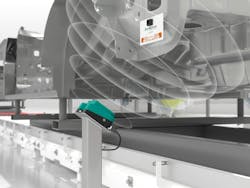In 1945, Walter Pepperl and Ludwig Fuchs founded a small radio workshop in Mannheim, Germany, based on the principles of inventiveness, entrepreneurial foresight and self-reliance. The experience they acquired was transformed into new ideas, and they developed products for customers. The eventual result was the invention of the proximity switch, the starting point of the company's success story. Pepperl+Fuchs now is known for a variety of electrical explosion protection and sensor technology, including radio-frequency identification (RFID). Mike McCabe is product manager, factory automation systems, at Pepperl+Fuchs, where he's worked since 2019.
Q: How scalable is RFID technology for large-scale industrial applications?
A: RFID technology works well for large-scale industrial applications when selecting capable equipment and partners. Here are some considerations:
Tag and reader capacity: Material-handling applications and tracking goods within a supply chain are a good example of a large-scale industrial application. Having an RFID device designed specifically for this task is necessary. Pepperl+Fuchs has recently released an UHF RFID reader for gate applications—IUR-F800-V1D-4A-FR2-02—which can read up to 200 tags very quickly. It covers a large area so that forklifts and even tractor-trailers can carry goods past a waypoint, ensuring that all tags are read. With the help of additional sensors, the direction can also be detected, for example, indicating a forklift is transporting goods from Warehouse A to Warehouse B.
Large corporations such as Walmart, UPS, and others have started requiring RFID tags to be attached to a majority of their assets. This mean lots of tags are needed. Pepperl+Fuchs offers an extensive line of RFID tags but can also help direct customers to tag manufacturers who specialize in large tag volumes. Pepperl+Fuchs’ specialty has always been producing reliable RFID hardware that is easy to implement.
Data volume: Large-scale operations may require increased data volumes. Some RFID devices make it easier to handle large amounts of data. For instance, the newer stand-alone industrial Ethernet UHF reader—IUT-F190-B40-2V1D-FR2-02—from Pepperl+Fuchs specializes in sending lots of data quickly to PLCs (EtherNet/IP and PROFINET) and the cloud (REST API and OPC UA). Pepperl+Fuchs’ IDENTControl could also be used for more complex applications. A customer may not want to choose an IO-Link-enabled RFID device due to IO-Link protocol’s inherent limitation to 32 bytes of data. If more than 32 bytes are required, multiple data packets are needed, which means more time and effort. IO-Link RFID devices are ideal for simple applications with little data.
Environmental factors: When tracking assets in a large facility or supply chain, several harsh environments may be encountered, requiring equipment that meets IP, temperature, and hazardous protection standards. While high IP ratings have always been a focus of Pepperl+Fuchs RFID products, the goal is also to operate in a wide range of temperatures. Many of the devices can modulate power in such a way to prevent overheating in hot environments. Also important is the ability to install read/write devices in hazardous environments. Fortunately, Pepperl+Fuchs has a long history of providing explosion-proof enclosures for RFID devices; whether C1 or C2, Pepperl+Fuchs has it covered.
Q: What are typical data transfer rates for RFID, and how do they affect real-time control processes? What challenges or limitations does RFID have in high-speed manufacturing environments, and how can they be overcome?
A: Data transfer rates have an impact on real-time control processes. Therefore, consideration should be given to which devices are selected and how the data is used. This will ensure the continued success of RFID in high-speed manufacturing environments.
Frequency selection: For new RFID applications and product developments, two frequencies have come to dominate the market, and for good reason. Both high-frequency (13.56 MHz) and ultra-high frequency (860 MHz – 960 MHz) are able to handle real-time control processes due to their high data transmission rates.
Data amounts: The more data is read or written, the more time is required. While several kilobytes of data can be stored on an RFID tag, some installers prefer to store a lot of data in an auxiliary database and use the tag for identification only, linking the two together. This can be much faster than attempting to access large data sets via the tag.
Simultaneous communication: Many new RFID devices from Pepperl+Fuchs now enable the simultaneous communication to both PLCs and the cloud (MQTT, OPC UA, REST API). When real-time control of a process is required, the PLC still enables faster control. Customized SW applications via the cloud are becoming more common, but mainly for condition monitoring and status updates.
Read/write range: RFID devices create fields of energy. When tags are in these fields, their antennas can collect enough energy to allow their chips to be read or written to. The larger the field, the faster a tag can move through the field while still receiving enough energy for reading or writing. Ultra-high frequency offers much larger fields and therefore higher passing speeds, which is well suited to high-speed manufacturing environments. However, HF also has its uses. For example, Pepperl+Fuchs recently announced an extended range high-frequency RFID device—IQT3-FP-IO-V1 and IQH3-FP-V1. These new devices double the existing high-frequency read ranges, which again can contribute to faster passing speeds.
Environmental interference: Pepperl+Fuchs provides shielded cables and the ability to ground RFID devices to ensure electro-magnetic interference does not corrupt data transmission.
Q: How can RFID equipment integrate with existing control systems and equipment?
A: Integration into existing control systems and installations is possible with the right devices and know-how.
Challenges arise when installers face outdated protocols and tag frequencies that are no longer supported.
First, to deal with an outdated protocol, a device such as Pepperl+Fuchs DeviceMasters enables the installer to translate an old protocol into a more widely used protocol such as EtherNet/IP, PROFINET or EtherCAT.
The second issue concerns installations where outdated RFID frequencies are used. In these cases, tags with these obsolete, proprietary frequencies can no longer be purchased; thus an application cannot be easily upgraded. In such cases, the user may choose to switch everything to high frequency or ultra-high frequency. While the changeover may be a hard pill to swallow, these two frequencies are now standard and will be supported for many years to come.
If the customer is looking to expand an existing high-frequency application, Pepperl+Fuchs has recently released the extended-range high-frequency RFID device—IQT3-FP-IO-V1 and IQH3-FP-V1. Converting everything to ultra-high frequency to increase range is no easy task. Since Pepperl+Fuchs has figured out how to double the high-frequency range up to about 12 inches, switching to a different frequency may not be necessary. This extended range offers additional benefits, such as the ability for the high-frequency reader to read multiple tags and selectable power settings.
There are other cases where a customer may prefer to use high frequency rather than ultra-high frequency. Ultra-high frequency radiates electromagnetic waves into the environment. These waves can bounce off metal and each other, creating areas of strong or poor readability. PowerSweep is one method to combat this problem. Radiating waves far into the environment can also cause unwanted tags to be read or written. High frequency RFID technology produces shorter read/write fields, but the field, based on inductive technology, is very coherent, and it is easier to read just one tag at a time.
Q: What are the different types of RFID tags available and their respective capabilities?
A: What’s special about RFID technology is that it has become very standardized over the years. Pepperl+Fuchs carries many RFID tags, but their RFID devices also work with many tags on the market; the frequency and ISO standard simply have to match that of the RFID device.
Tag diversity: The market offers a diversity of tags, covering most conceivable applications. Sometimes a tag manufacturer may focus on perfecting a tag for one specific application. Tire tag manufacturers are very specialized since their RFID tags have to withstand the extreme conditions of the vulcanization process in tire manufacturing. There are tags that can detect when a pill bottle has been opened. There are even tags that have integrated sensors to transmit data on strain, moisture, temperature and more.
Pepperl+Fuchs tag portfolio: Pepperl+Fuchs carries many specialty tags. Some can withstand up to 450 °F, while others can withstand being hit with a hammer and still function reliably. Some tags can be embedded in drill pipes that can penetrate the earth’s crust below the ocean. Pepperl+Fuchs also carries many inexpensive stick-on label tags that are sufficient for most applications.
When selecting tags, also pay attention to the following:
- Tags are typically designed for use on metal, in metal, or on any materials other than metal. Be sure to select a tag that meets the requirements of the application.
- Some tags are read-only, although these still provide serialized data, which may be sufficient.
- Tags come in all shapes and sizes. How much space is available on the asset for tagging?
- How many tags are needed? The cost of tags has come down over the years, mainly because embedded silicon chips are getting smaller, but some tags with unique features can still be pricey, especially if many of them are needed.
Q: What are the security implications of using RFID in industrial settings?
A: While RFID provides numerous benefits in an industrial setting, it is advisable to always consider the security aspects.
Data interception: Since RFID information is transmitter over the air, nefarious actors could attempt to retrieve data with malicious intent.
Unauthorized users: RFID tags can be cloned, allowing users to access devices they are not authorized to use.
Data integrity: A user could modify data on a tag in such a way that the overall process is compromised in some way.
Pepperl+Fuchs takes security very seriously. As cloud communication becomes more prevalent, it is especially important to design RFID controllers to provide increased security options. Options to control data access are crucial. The ICE2 IO-Link master, for example, does not allow a user to modify data unless they are logged in as an authorized administrator. Newer devices are equipped with strong and unique passwords. A very common RFID application equips machine users with RFID cards that give them access to authorized machines.


